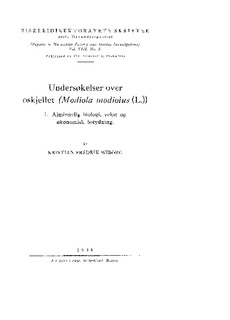| dc.description.abstract | The horse-mussel, Modiola modiolus (L.) is a bivalved mollusk
dosely related to the sea mussel, Mytilus edulis L. and common in
northern waters. In Norway there are considerable beds of this mussel
along the western and northern coasts, from just below the littoral
region to about 80 meters of depth. The horse-mussel plays an important
part as bait in the set-line fisheries, especially in the Lofoten "skrei"-
fisheries. As some of the mussel beds have been exhausted, and others
are in danger of being depleted, investigations have been initiated by
the Fisheries Directorate of Norway in order to study the biology of the
horse-mussel, especially the growth and propagation of the mussel and
the renewal of the beds. In some places the horse-mussel together with
other organisms form a special community, the Modiola modiolus community,
which is described more closely.
The food of the horse-mussel consists of plankton, mainly small
phytoplankton forms and protozoa, and detritus, the latter playing an
important part.
The chief enemies of the horse-mussel are the starfishes Asterias
rubens and A. glacialis. Other enemies are some sea-urchins, the whelk,
dog whelk, the crab Cancer pagurus, the cat fish and the eider duck. Seaweed
(Laminaria digitata) sometimes smother the mussels and heavy
sea may sweep them up on the shore.
In individuals from shallow water the siphones and mantle edges
are sometimes coloured green by a small, globular flagellate of a species
not yet determined.
The sexes are separate, hermaphrodites occurring in 2-8 ‰ of the
individuals. The proportion of males to females is usually 1 : 1, but
on some occasions more males than females are found among the smaller
individuals and more females among the larger ones.
The horse-mussel reaches maturity from the 3. to the 8. year of
life, the majority at an age of 5 to 6 years.
The genital tissue has the same arrangement as in the sea mussel
except the mantle lobes, which are thin and membranlike, similar to
those of young sea mussels.
The genital tissue of male and female is described. A female mussel
of 110 mm length will yield about 20 millions of eggs.
Spawning usually takes place in March-April and may be accomplished
within one day. All mussels in a bed will usually spawn
at the same time. Most often there will be an interval of two or more
years between each spawning.
Larval development is supposed to be accomplished within a month.
The spat fall is small compared with that of the sea mussel.
The growth has been investigated both experimentally and on the
base of the growth rings. These have proved to be annual rings except
in a few cases, when secondary rings are formed. These are, however,
easily distinguished from the annual rings.
Growth is comparatively rapid from July to October-November,
when it slows down, and almost entirely ceases between December and
April, in which period the winter rings are formed. In May-June the
growth is resumed.
The most rapid growth is usually shown by the smaller individuals
up to 55 millimeters of length (about 8 years of age) Which have an
average annual growth of 6-10 mm. The maximum growth found
experimentally was 15 mm. After the 10. year growth slackens, and in
individuals 14 years old or more the growth scarcely exceeds 2-4 mm
a year.
In the localities examined individuals 10 years old on an average
measured 65-79 mm, 18 years old 98-118 mm. The best growth was
recorded from mussels living at a depth of 6-15 meters in fjords and
sounds with strong water movement and frequent renewal of the water
layers.
The horse-mussels commonly used as bait measure from 80 to
140 mm of length and are from 10 to 20 years old. The normal length
of life is estimated to be about 23 years, but individuals have been found
up to an age of 36 years.
The age composition of the stocks of mussels is very varying in
different localities, the percentage of younger specimens sometimes
being very small.
The proportions of the horse-mussel are discussed. Between length
and height there is the following relation: H = L/(a+bL) where a and b
are constants. Between breadth and length the relation is B = cL,
c being a constant. The outer volume can be calculated from the formula
V = L.B.H.d or V = L³cd/(a+bL) or approximately V = L³k. For values
of the constants a, b, c, d, and k see page 43 and 48. Mussels of good
quality yield 1/6-1/10 of the total volume as salted meat.
Analysis of weight and chemical composition have been undertaken.
Different tools for collecting horse-mussels are described.
In preparation for bait the meat is removed from the shells and
salted in casks of 30 liters. Commonly 600-800 nmssels will yield one
cask.
The horse-mussels are used as bait in the set-line fisheries mainly
in the Lofoten area ("skrei"-fisheries) but also in other coastal set-line
fisheries. The method of preserving the meat with salt was first employed
commercially in 1883.
Commercial fishing on a bigger scale for horse-mussels at first took
place in the fjords and streams near Bergen on the west coast of Norway
(1883) but soon spread to other localities.
The counties which yield most part of the horse-mussels are Hordaland
on the west coast and Trøndelag and Nordland in the northern
part of Norway.
The total catch in the years 1914-1943 varied from 678 to 5 876
hundreds of liters (salted mussels), the economic value of the catches
from 73 000 to 440 000 kroner.
The protection and possible cultivation of the horse-mussel beds
are discussed. No laws of protection have as yet been enacted. Cultivation
of the horse-mussel will probably be difficult on account of the
tardy growth and small power of regeneration. | |
